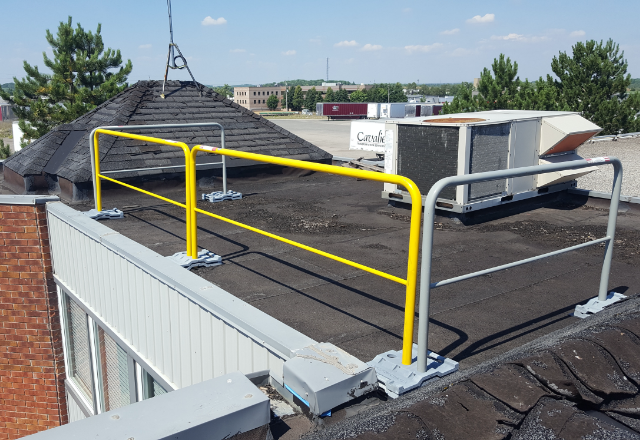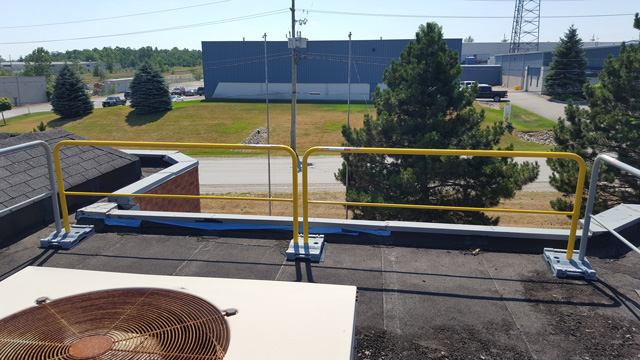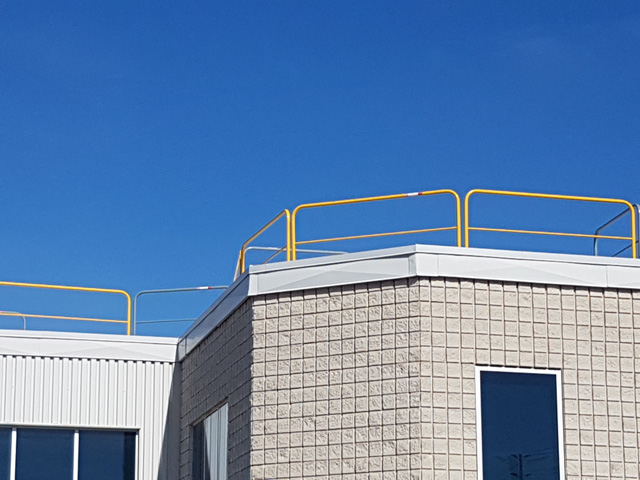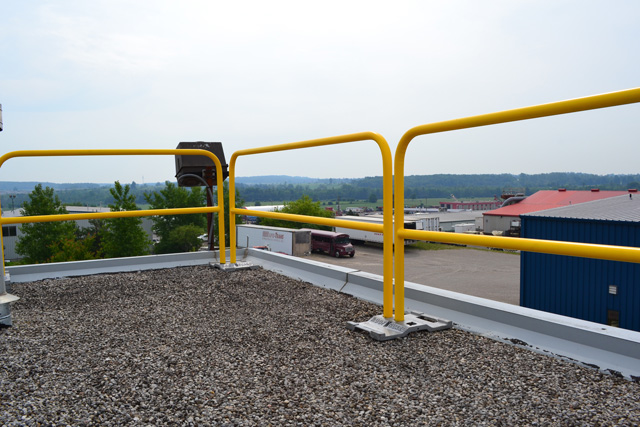Rooftop Guardrail | X-Press Series
Modular, easy-to-install fall protection system for temporary rooftop safety




The Rooftop Guardrail | X-Press Series is a versatile, easy-to-install fall protection system designed for Canadian rooftop safety standards. With pre-fabricated rail sections, it can be quickly assembled or dismantled for temporary or permanent use—without compromising strength, durability, or safety.
Customize your own layout with linear coverage options ranging from 8 feet to over 100 feet.
Note: Sold by rail length.
The X-Press Series includes:
Grated slip-resistant walkways
Complete installation manual and layout drawings
Counterweighted baseplates
Rubber pads to protect roof membranes
Vertical posts and horizontal rails
Set screws for secure assembly
KEY FEATURES
Easy Installation
Quick to assemble and install on most rooftop types, no specialized tools required
Modular Design
Flexible, reconfigurable system that adapts to nearly any rooftop layout
OHS Compliant
Engineered to meet or exceed Canadian safety regulations, including provincial OHS and WorkSafeBC standards
CORROSION RESISTANT
Constructed from lightweight aluminum for excellent resistance to rust and corrosion
non-penetrating system
Counterweighted design protects the roof membrane, no drilling required
DESIGNED by Engineers
Custom rooftop safety solutions developed by our experienced in-house engineering team
CUSTOM CONFIGURATION
Offered in ready-to-install kits or customized solutions to suit specific Canadian rooftop needs
FLEXIBLE OPTIONS
Protects individual rooftop features or provides full or partial perimeter fall protection
Talk to a specialist today
Fall Protection Regulations in Canada
| Jurisdiction | Regulation |
|---|---|
| Federal (Canada) | Canada Occupational Safety and Health Regulations, SOR/86-304, Sections 12.01 to 12.09 |
| Ontario |
|
| Quebec |
|
| Alberta | Occupational Health and Safety Code, 2009 Part 9, Fall Protection Sections 138 - 161 |
| British Columbia | Occupational Health and Safety Regulations, B.C. Reg. 296/97 Part 11, Fall Protection, Sections 11.1 to 11.10 |
| Manitoba | Workplace Safety and Health Regulation, Man. Reg. 217/2006 Part 14, Fall Protection, Sections 14.1 to 14.23 |
| New Brunswick | General Regulation -N.B. Reg. 91-191 Part VII, Protective Equipment, Sections 49 - 51 |
| Newfoundland and Labrador | Occupational Health and Safety Regulations, 2012, N.L.R. 5/12 Part X, Fall Protection, Sections 138 to 146 |
| Nova Scotia | Workplace Health and Safety Regulations, N.S. Reg. 52/2013 Part 21, Fall Protection, Sections 21.1 to 21.4 |
| Prince Edward Island | Fall Protection Regulations, EC2004-633 |
| Saskatchewan | Occupational Health and Safety Regulations, 1996, R.R.S., C. O-1.1, R. 1 Sections 102 to 107, and Sections 116 to 116.3 |
| Northwest Territories |
|
| Nunavut | General Safety Regulations, R.R.N.W.T. 1990, c. S-1, Part 7 Sections 104 to 109, and Part 9, Sections 118 to 122 |
| Yukon |
|
Your Perfect Solution Awaits!
Frequently Asked Questions
When is fall protection required?
Employers must provide protection to prevent employees from falling. According to Canadian Centre for Occupational Health and Safety (CCOHS) laws, any surface 3 metres (10 feet) above another level requires fall protection. In most cases, fall protection is required when:
- other means of fall protection are not available or possible, such as guardrails
- working at a height of 3 metres or more (permanent and/or temporary work areas)
- working at a height of less than 3 metres when the surface below could cause a greater injury than just the fall (e.g., machinery; risk of drowning in water or other liquid; open tanks, vats, or pits containing hazardous materials; materials that can shift)
- a worker may fall through an opening in the work surface
- it is determined that fall protection is necessary
I don’t know if I need a rooftop guardrail system. Can Liftsafe Fall Protection help me decide?
For sure! Fall protection regulations can be tricky, so if you’re unsure whether a rooftop guardrail system is the right solution, we can help. Just click here to fill out the form with as much detail as possible and our team will get back to you as soon as possible for a complete consultation. You can also reach our team directly at:
Phone: 1-800-977-2005
Email: info@liftsafegroup.com
Do RoofGuard Guardrail Systems comply with current US/Canada safety regulations?
What is the difference between active and passive fall protection?
Both active and passive fall protection are effective in protecting workers from falling. However, while active protection requires involvement from the worker, passive systems can keep people safe regardless of training level and awareness of a hazard.
Active fall protection are known as Personal Fall Arrest Systems (PFAS), such as body harnesses, lanyards, and anchor points. Passive fall protection, alternatively, are physical barriers or systems, such as guardrails and safety nets, that prevent workers from falling or catch them if they do fall.
Passive solutions are always preferred to active ones. They represent engineering controls that keep people safe regardless of training level and awareness of a hazard.
How can I purchase RoofGuard Guardrail Systems from Liftsafe Fall Protection?
It’s pretty simple. Click here to request a quote and our team will get back to you as soon as possible. Don’t forget to fill out the form with as much detail as possible so we can provide a precise quote. You can also reach our team directly at:
Phone: 1-800-977-2005
Email: info@liftsafegroup.com
How long does it take to install a rooftop guardrail? Does it require any special tools or skills?
Roofguard is incredibly simple to install and can be easily installed by an inexperienced worker with simple hand tools and our instructions. Each system has labels that contain a QR code linking to a series of videos showing exactly how to install it for maximum time savings.
Are RoofGuard Guardrail Systems certified by an engineer?
Each RoofGuard system comes with a stamped engineering drawing back by the in-house engineering team at Liftsafe Fall Protection.
Are guardrails more expensive than horizontal lifeline systems?
While every system is different, at times the initial costs of guardrail can be slightly more compared to horizontal lifeline systems. However, you also need to consider the costs of certifying employees for working at heights (every three years), anchor point inspections (annually), lanyard and harness costs and inspections (annually), recordkeeping (ongoing), a rescue plan, and other related costs. When you take these into account, the overall cost of an installed guardrail system is much lower when compared to horizontal lifeline systems.
There is also the amount of time and resources that must be devoted to making sure these are all adhered to. Whereas, a guardrail system can be set up once and you are instantly compliant.
Are the materials used in the RoofGuard Guardrail Systems protected from corrosion and other environmental factors?
Yes. RoofGuard Guardrail Systems are typically made of aluminum, which ensure durability in diverse weather conditions. They are designed to be protected from corrosion, rust and other environmental factors, and its components contribute to resistance to environmental wear and tear.
How does the RoofGuard Guardrail stay in place if it isn't secured to the roof?
The RoofGuard Guardrail System is a modular, non-penetrating system designed to eliminate the potential hazard of falls over unprotected edges on a rooftop or elevated surface. It is counter weighted, which means it requires no welding, drilling, or bolting into the actual roof structure, and is designed to rest on top of it while still meeting lateral force requirements set out in the appropriate standards and laws.
Can RoofGuard Guardrail Systems be painted?
Yes. RoofGuard comes standard as an aluminum system that is grey but some clients prefer it to be painted safety yellow. This is done in-house with a powder coated paint that is weather resistant.
Can RoofGuard Guardrail Systems be used as an anchor?
No. RoofGuard must not be used as an anchor. This is stated explicitly in the RoofGuard installation manual among other safety requirements.
Can RoofGuard Guardrail Systems be installed on a sloped roof?
Yes. This depends on how steep the slope is for standard systems (it must meet the standards and regulations for sloped roofs). However, custom systems are available for multiple applications including sloped roofs.
RELATED PRODUCTS
FIXED LADDER | ROOFCLIMB SERIES
Fall protection systems designed to provide safe and efficient access to rooftops and elevated surfaces.
ROOFTOP GUARDRAIL | ROOFGUARD SERIES
Fall protection systems designed to protect workers performing tasks near rooftop edges.
Rooftop Protection Program
Our rooftop protection program uses 6 stages to systematically assess fall hazards on rooftops, prioritize risks, and implement compliant safety solutions.
